rayscale: ; --tw-hue-rotate: ; --tw-invert: ; --tw-saturate: ; --tw-sepia: ; --tw-drop-shadow: ; --tw-backdrop-blur: ; --tw-backdrop-brightness: ; --tw-backdrop-contrast: ; --tw-backdrop-grayscale: ; --tw-backdrop-hue-rotate: ; --tw-backdrop-invert: ; --tw-backdrop-opacity: ; --tw-backdrop-saturate: ; --tw-backdrop-sepia: ; margin-top: 0px; margin-bottom: 1.25em; overflow-wrap: break-word; white-space: pre-wrap; color: rgb(20, 23, 24); font-family: __Karla_555e8b, __Karla_Fallback_555e8b, ui-sans-serif, system-ui, -apple-system, BlinkMacSystemFont, "segoe ui", Roboto, "helvetica neue", Arial, "noto sans", sans-serif, "apple color emoji", "segoe ui emoji", "segoe ui symbol", "noto color emoji"; letter-spacing: -0.16px; background-color: rgb(243, 245, 247);">Silkworm chrysalis and cicada chrysalis are both the form of insect larvae in the pupation stage, but they refer to different insect species and life habits. Here is a detailed introduction to silkworm pupae and cicada pupae to help differentiate between them:
rayscale: ; --tw-hue-rotate: ; --tw-invert: ; --tw-saturate: ; --tw-sepia: ; --tw-drop-shadow: ; --tw-backdrop-blur: ; --tw-backdrop-brightness: ; --tw-backdrop-contrast: ; --tw-backdrop-grayscale: ; --tw-backdrop-hue-rotate: ; --tw-backdrop-invert: ; --tw-backdrop-opacity: ; --tw-backdrop-saturate: ; --tw-backdrop-sepia: ; margin-top: 0px; margin-bottom: 1.25em; overflow-wrap: break-word; white-space: pre-wrap; color: rgb(20, 23, 24); font-family: __Karla_555e8b, __Karla_Fallback_555e8b, ui-sans-serif, system-ui, -apple-system, BlinkMacSystemFont, "segoe ui", Roboto, "helvetica neue", Arial, "noto sans", sans-serif, "apple color emoji", "segoe ui emoji", "segoe ui symbol", "noto color emoji"; letter-spacing: -0.16px; background-color: rgb(243, 245, 247);">
silkworm chrysalis:
Insects that produce silkworm aphids:
Silkworm chrysalis refers to the larval form of silkworm larvae that develops through pupation after completing the leaf-eating growth stage. Bombyx mori are an important source of silk production.
Appearance features:
Silkworm chrysalis larvae are larger, milky white in color, plump and have a certain curved shape, indicating that the larvae are in the state of pupation.
Economic Value:
Silkworm chrysalises are famous because their cocoons, made of silk, are of high economic value in silk production. Silkworm farmers will boil the cocoons in hot water and then unfold them for silk processing.
Living habits:
During the process of pupation, silkworms spend several weeks in a quiet period in the cocoon, during which they undergo physiological and morphological changes and eventually transform from the cocoon into a mature moth.
Cicada pupa:
Insects that produce cicadas:
Cicada pupa refers to the protective pupa shell formed by the larvae of cicada insects underground or in other suitable environments after molting. After going through the pupa stage, they will become cicadas.
Appearance features:
Cicada pupae are usually brown or black in color and have a hard shell. Cicada pupae are usually compact in shape, wrapped in a hard shell, and have a distinct cicada-shaped outline.
life cycle:
The cicada in the pupa will emerge from the pupa shell at the end of the pupation period, crawl to the ground or plants, and begin to molt into a cicada. Cicadas are periodic insects with special habits such as shedding their skin and making sounds.
Summary of differences:
Source insects:
Silkworm chrysalis is the pupa form of silkworms, and the production of silk has economic value; cicada chrysalis is the pupa form of cicada insects, with special peeling and vocal habits.
Appearance features:
Silkworm pupae are usually milky white, larger and plump; cicada pupae are usually brown or black and have a hard shell.
Silkworm pupae and cicada pupae both represent an important developmental stage in insect life and have certain economic value and ecological significance. Their pupation process and life habits are unique in the insect world and are closely related to their adult stages.
animal tags: silkworm cicada chrysalis
We created this article in conjunction with AI technology, then made sure it was fact-checked and edited by a Animals Top editor.